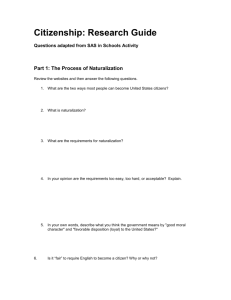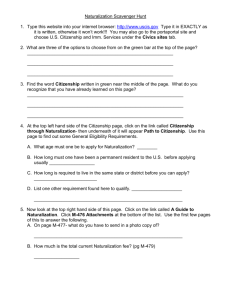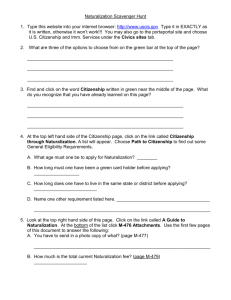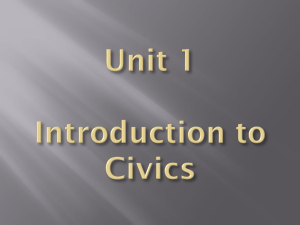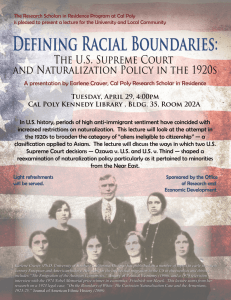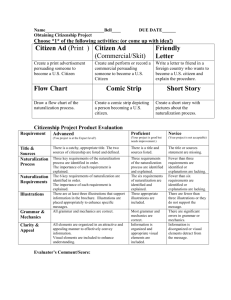National Identity & Citizenship
advertisement
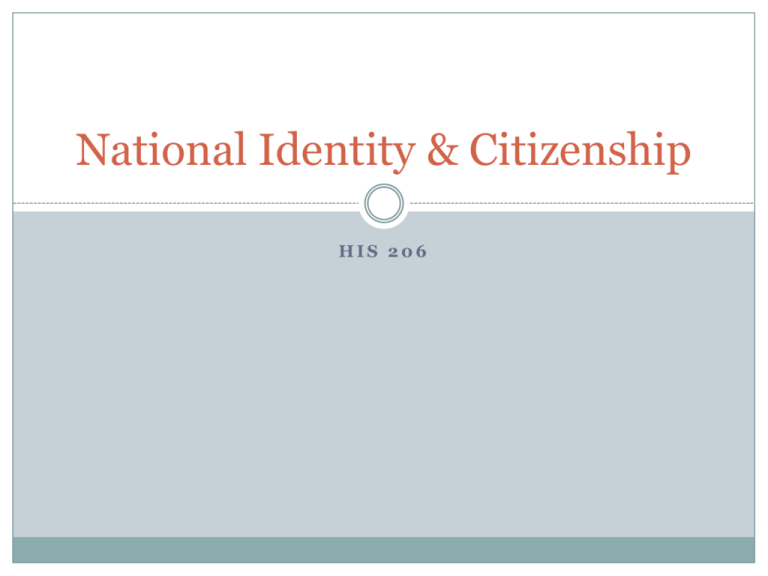
National Identity & Citizenship HIS 206 Ideological Definition of National Identity Republican ideology claims universal application Social contract theory Citizens’ rights emphasized Rhetoric contradicted by reality, however Egalitarian principles which define U.S. citizenship: Assimilation – conforming to dominant culture Asylum – welcoming refugees seeking political or religious liberty Assimilation Traditional assumption that nations were bound by common language, religion & culture didn’t apply to U.S. British heritage dominant, however Michael-Guillaum Jean de Crevecoeur expressed confidence in melting pot in his Letters from an American Farmer (1782) Assimilation eliminated differences Celebrated “this great American asylum” Asylum Willingness to be asylum dependent upon confidence in assimilation Refugees had to assimilate Noble ideal of providing asylum lent moral purpose to assimilation Asylum helped distinguish New World from old, as Thomas Paine wrote in Common Sense (1776) Throughout first 100 years, confidence in assimilation remained high Citizenship Ancient Greeks est. basis for modern idea of citizenship Fused 2 concepts: Notion of state having boundaries within which decisions are made about inhabitants’ lives Notion of inhabitants participating in decision-making process as joint proprietors Romans extended definition & scope of citizenship as empire expanded – finally made all free inhabitants citizens in 212 CE Articles of Confederation (1777-1788) left citizenship & naturalization up to each state Naturalization Constitution (1788 - ) gave Congress power over immigration & naturalization Immigrants barred from Presidency, & residency requirements for House & Senate Art. I, Sec. 8 allows Congress to est. uniform rule of naturalization Art. I, Sec. 9 allows Congress to regulate immigration, with $10 limit on head tax Naturalization Act of 1790 limited citizenship to “free white persons” of “good moral character” Residency requirement: 2 years in country, 1 in state Courts determined eligibility & administered oath of allegiance Making Naturalization More Difficult Naturalization Act of 1795 raised residency requirement to 5 years & required declaration of intent to seek citizenship 3 years prior to naturalization Naturalization Act of 1798 part of Alien & Sedition Acts – caused by Quasi-wartime hysteria raised residency requirement to 14 years & forbade naturalization of enemy aliens Alien Act gave President power to deport aliens who were “dangerous to the peace & safety of the United States” Alien Enemy Act allows President to detain or deport enemy aliens in wartime Naturalization Act of 1802 lowered residency requirement back to 5 years, but required sworn testimony of 2 witnesses Expanding Eligibility for Citizenship 1855 act granted derivative citizenship to foreign-born wives & children of U.S. citizens 1907 law stripped citizenship from women who married aliens Repealed in 1922 in cases of marriage to Europeans, but not until 1931 in cases of marriage to Asians 1870 Naturalization Act extended eligibility to “persons of African nativity and African descent” 1906 Naturalization Act standardized process to eliminate fraud & competition between courts Required filing of Declaration of Intent (‘first papers”) & then petition 27 years later Created Bureau of Naturalization to complement Bureau of Imm. Required knowledge of English language for the 1st time Tracking Resident Aliens Alien Registration Act (1940) required registration & finger-printing of all aliens over 14 years old 1990 Immigration Act transferred exclusive jurisdiction to Attorney General Lowered state residency requirement to 3 months Created exceptions to English language requirement 1940 Alien Registration Card Modern “Green Card”
